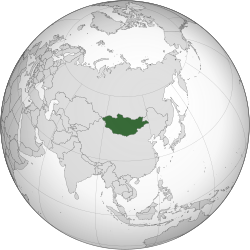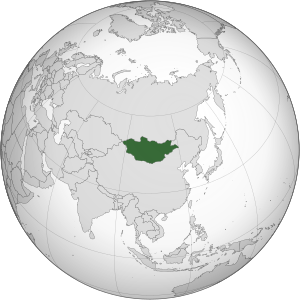मङ्गोलिया
स्वरूप
Mongolia | |
|---|---|
राष्ट्रिय गान:
| |
 उल्लेखित नक्सा मङ्गोलिया (green) | |
| राजधानी र सबैभन्दा ठूलो सहर | Ulaanbaatar[a] Coordinates: 48°N 106°E / 48°N 106°E |
| सबैभन्दा ठूलो शहर | capital |
| आधिकारिक भाषाअन | Mongolian |
| Official scripts | |
| जातिगत समूहअन (2010) | |
| धर्म | Buddhism (53%) Non-religious (38.6%) Islam (3%) Shamanism (2.9%) Christianity (2.2%) Others (0.4%)[२] |
| रैथाने(एन) | |
| सरकार | Unitary semi-presidential republic[३][४][५] |
| Khaltmaagiin Battulga | |
| Ukhnaagiin Khürelsükh | |
| व्यवस्थापिका | State Great Khural |
| Formation | |
| formed 209 BC | |
| formed 1206 | |
| December 29, 1911 | |
• Mongolian People's Republic was established | November 26, 1924 |
• Independence was recognized by China | January 5, 1946 |
| February 13, 1992 | |
| क्षेत्रफल | |
• जम्मा | 1,566,000 km2 (605,000 sq mi) (18th) |
• पानि (%) | 0.67[२] |
| जनसङ्ख्या | |
• 2020 लगत | 3,353,470[६] (134th) |
• 2015 जनगणना | 3,057,778[७] |
• घनत्व | 2.07/km2 (5.4/sq mi) (194th) |
| कुल ग्राहस्थ उत्पादन (क्रय शक्ति समता) | 2019 लगत |
• जम्मा | $47 billion[८] (115th) |
• प्रति व्यक्ति | $14,270[८] (93rd) |
| कुल ग्राहस्थ उत्पादन (साङ्केतिक) | 2019 लगत |
• जम्मा | $13.7 billion[८] (133rd) |
• प्रति व्यक्ति | $4,151[८] (116th) |
| गिनी (2018) | 32.7[९] मध्यम |
| मानव विकास सूचकाङ्क (2018) | उच्च · 92nd |
| मुद्रा | Tögrög (MNT) |
| समय क्षेत्र | अन्तर्राष्ट्रिय प्रमाणिक समय+7/+8[११] |
• ग्रीष्मकालिन (दिवाप्रकाश समय बचत) | अन्तर्राष्ट्रिय प्रमाणिक समय+8/+9[१२] |
| मिति ढाँचा | yyyy.mm.dd (CE) |
| सडक प्रयोग | right |
| टेलिफोन कोड | +976 |
| आइएसओ ३१६६ सङ्केत | MN |
| इन्टरनेट डोमेन | .mn, .мон |
| |

मंगोलिया एसिया मी रयाको एक देश हो।
सन्दर्भ
[सम्पादन • स्रोत सम्पादन]- ↑ "Official Documents to be in Mongolian Script", June 21, 2011. छाड्डिबार पुग्या मिति:2010-07-11.
- ↑ २.० २.१ २.२ "Mongolia". The World Factbook. CIA. Archived from the original on July 3, 2015. Retrieved August 9, 2015.
- ↑ Shugart, Matthew Søberg (September 2005). "Semi-Presidential Systems: Dual Executive and Mixed Authority Patterns" (PDF). Graduate School of International Relations and Pacific Studies. Archived from the original (PDF) on August 19, 2008. Retrieved 21 February 2016.
- ↑ Shugart, Matthew Søberg (December 2005). "Semi-Presidential Systems: Dual Executive And Mixed Authority Patterns" (PDF). French Politics. 3 (3): 323–351. doi:10.1057/palgrave.fp.8200087. Archived (PDF) from the original on March 4, 2016. Retrieved February 21, 2016.
Even if the president has no discretion in the forming of cabinets or the right to dissolve parliament, his or her constitutional authority can be regarded as 'quite considerable' in Duverger’s sense if cabinet legislation approved in parliament can be blocked by the people's elected agent. Such powers are especially relevant if an extraordinary majority is required to override a veto, as in Mongolia, Poland, and Senegal.
- ↑ Odonkhuu, Munkhsaikhan (February 12, 2016). "Mongolia: A Vain Constitutional Attempt to Consolidate Parliamentary Democracy". ConstitutionNet. International IDEA. Archived from the original on February 25, 2016. Retrieved February 21, 2016.
Mongolia is sometimes described as a semi-presidential system because, while the prime minister and cabinet are collectively responsible to the SGKh, the president is popularly elected, and his/her powers are much broader than the conventional powers of heads of state in parliamentary systems.
- ↑ "Renewed 2015-2045 population projection". www.1212.mn. Mongolian Statistical Information Service. 1 January 2017. Retrieved 28 May 2020.
- ↑ "2015 population and housing by census of mongolia". www.1212.mn. Mongolian Statistical Information Service. 1 January 2016. Retrieved 28 May 2020.
- ↑ ८.० ८.१ ८.२ ८.३ "World Economic Outlook Database, January 2019". IMF.org. International Monetary Fund. Retrieved 24 February 2019.
- ↑ "GINI index (World Bank estimate) - Mongolia". data.worldbank.org. World Bank. Retrieved 22 March 2020.
- ↑ "Human Development Report 2019" (PDF) (in अङ्ग्रेजी). United Nations Development Programme. 10 December 2019. Retrieved 10 December 2019.
- ↑ "Mongolia Standard Time is GMT (UTC) +8, some areas of Mongolia use GMT (UTC) +7". Time Temperature.com. Archived from the original on October 13, 2007. Retrieved September 30, 2007.
- ↑ "Clock changes in Ulaanbaatar, Mongolia". timeanddate.com. Archived from the original on March 25, 2015. Retrieved March 27, 2015.
भाइरका कडि
[सम्पादन • स्रोत सम्पादन]| एशियामा पड्या देश | |
|
अजरबैजान •
|

|


